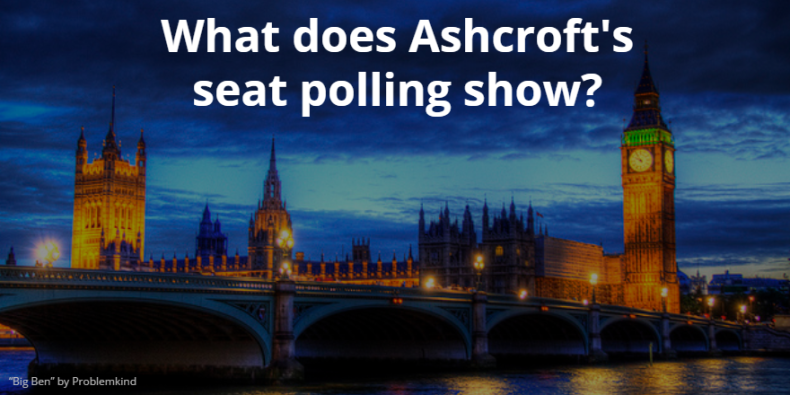 How many seats might Lib Dems win?Conservative peer Lord Ashcroft has now polled 38 Liberal Democrat held constituencies (counting Portsmouth South as Lib Dem held although its MP is now sitting as an independent), having started working his way up from the most marginal. In those seats, his polling finds the party ahead in 17, dead tied in two and behind in the others. Although the wording of his polling questions is good, getting voters to think about their local constituency, he doesn’t name candidates in the questions – which where there is an MP with a personal vote is likely to depress the party’s share. (For more on his methodology see Liberal Democrat Newswire #52 and it’s noteworthy how his polling results mirror the internal constituency polling conducted by the party. Reassuring too given the criticism of the party’s own polling accuracy after the 2010 election.) So a reasonable starting point in projecting seat numbers is to look at what happens if the party were to hold the seats not polled and those where it is currently tied or ahead. That would give the party 38 seats (important caveat – of which 11 are in Scotland). The number of held seats might be topped up by gains and Ashcroft’s polling has shown the Lib Dems in with a chance in a limited number of seats it doesn’t currently hold – although not ahead in any of them. As the more detailed breakdown below shows, especially with the number of seats in the 5% either way bands, there is a quite plausible for the party to hope to end up with 40+ seats in the next Parliament and hence an almost inevitable share of power in another hung Parliament. Not guaranteed by any means, and getting comfortably into the 40s requires a bit of a following political wind (finally) for the party, but clearly possible, just as the number of small margins shows the possibility of a much worse result too. There is still an awful lot to play for, and confident predictions about seat numbers tells you more about the over-confidence of the person making the prediction than anything else. Lib Dem ahead (by over 10%) Carshalton & Wallington Colchester Eastbourne Eastleigh Southport Sutton & Cheam Thornbury & Yate Lib Dem ahead (by 6-10%) Cheltenham Hazel Grove Kingston & Surbiton Lewes Lib Dem ahead (by 1-5%) Bermondsey & Old Southwark Birmingham Yardley Brecon & Radnorshire Cheadle Sheffield Hallam St Ives Tied North Cornwall Torbay Lib Dems behind (by 1-5%) Berwick upon Tweed Cambridge North Devon Portsmouth South St Austell & Newquay Taunton Deane Lib Dems behind (by 6-10%) Mid Dorset & North Poole Solihull Wells Lib Dems behind (by over 10%) Bradford East Brent Central Burnley Cardiff Central Chippenham Hornsey & Wood Green Manchester Withington Norwich South Redcar Somerton & Frome Possible gains (1-5% behind): Watford Possible gains (6-10% behind): Oxford West & Abingdon Possible gains (over 10% behind): Camborne & Redruth Hampstead & Kilburn Harrogate & Knaresborough Newton Abbot Truro & Falmouth How likely is that route to 40+ seats for the Liberal Democrats? Aside from the current snapshots provided by Ashcroft, the other major factor is how support changes between now and polling day – and in particular the relative intensity of the different local campaigns. On this, Ashcroft’s findings are mixed, finding the Liberal Democrats consistently out-campaigning Labour but sometimes struggling to match the level of Conservative activity. In addition to the interesting side-light that throws on Labour and its own troubles (its level of local activity are hardly that of a united party enthused by its leader), these activity figures show a clear relationship with party support. Excluding the June polling where the activity level figures are distorted by the European Parliament freepost, the correlation between level of Liberal Democrat support and level of campaign activity by the Liberal Democrats recalled by voters is 0.43. Or in other words, if the activity level is 10 percentage points higher in a seat, the Lib Dem vote is 4.3 points higher. There is an even higher 0.49 correlation between level of activity and change in vote share for the Lib Dems since 2010, where again higher activity goes with a better Lib Dem performance. Moreover, the current activity level scores, averaging at 26% of electors recalling a recent Lib Dem campaigning contact, show plenty of scope for increase. It’s a promising sign that the imminence of the 19 December long campaign election expenses start date has seen both a huge burst of voluntary activity in many seats to get campaigning done before then. Moreover, the party’s successful fundraising (frequently beating Labour in private donations and boosted by a huge recent bequest) has also seen a large slug of paid-for activity added in. (Note: the start date for the long campaign is 19 December. The Electoral Commission made a mistake in its guidance when it previously said it was 18 December.) | 








Leave a Reply